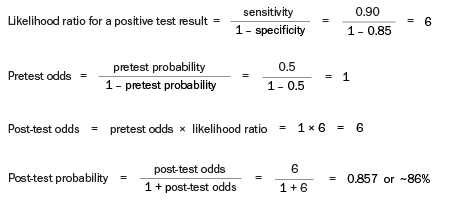Worked example estimating the post-test probability of iron-deficiency anaemia
The examples below illustrate the difference in post-test probability of iron-deficiency anaemia in an asymptomatic male (Estimating post-test probability of iron-deficiency anaemia: asymptomatic male with a positive ferritin result) and a symptomatic female (Estimating post-test probability of iron-deficiency anaemia: symptomatic female with a positive ferritin result). Assume that the prevalence of iron-deficiency anaemia in a 35-year-old male is around 2%, and the prevalence of iron-deficiency anaemia in a 35-year-old female is around 15%. A positive serum ferritin result (ie serum ferritin is low) has a specificity of 85% and a sensitivity of 90% for identifying iron-deficiency anaemia.
With a specificity of 85%, a ferritin test will have around 15% false positive findings. The 90% sensitivity means that the test will correctly identify around 90% of those with iron-deficiency anaemia.
Can you estimate the post-test probability of iron-deficiency anaemia in a 35-year-old male who doesn't have fatigue or pallor, but has a positive ferritin result?
This male has no other risk factors for iron-deficiency anaemia, so the pretest probability is the same as the prevalence in males of this age in the general population (2%). The calculated post-test probability of iron-deficiency anaemia in this male with a positive ferritin test is approximately 11% (see calculation below). This means that a ferritin test in a male with no symptoms is not useful.
Calculation:

Can you estimate the post-test probability of iron-deficiency anaemia in a 35-year-old female who has fatigue and pallor, and a positive ferritin result?
When the clinical findings suggest a higher pretest probability of iron-deficiency anaemia, the post-test probability is higher. If the pretest probability for this female is estimated to be 50% rather than 15%, the calculated post-test probability is around 86% (see calculation below). This means that a ferritin test in a female with symptoms is useful.
Calculation:

